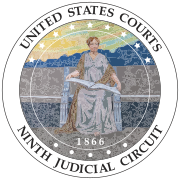United States v. Syufy Enterprises
| United States v. Syufy Enterprises | |
|---|---|
 | |
| Court | United States Court of Appeals for the Ninth Circuit |
| Full case name | United States of America v. Syufy Enterprises; Raymond J. Syufy |
| Argued | August 14, 1989 |
| Decided | May 9, 1990 |
| Citation | 903 F.2d 659 |
| Case history | |
| Prior history | 712 F. Supp. 1386 (N.D. Cal. 1989) |
| Court membership | |
| Judges sitting | Charles E. Wiggins, Alex Kozinski, Justin Lowe Quackenbush |
| Case opinions | |
| Majority | Kozinski, joined by Wiggins (in full); Quackenbush (in part) |
| Concurrence | Quackenbush |
| Laws applied | |
| Sherman Antitrust Act, 15 U.S.C. § 2; Clayton Antitrust Act, 15 U.S.C. § 18 | |
United States v. Syufy Enterprises, 903 F.2d 659 (9th Cir. 1990), was an antitrust case decided by the United States Court of Appeals for the Ninth Circuit.
Facts
[edit]The United States Department of Justice alleged that Syufy Enterprises had monopolized or attempted to monopolize the motion picture exhibition business in Las Vegas, Nevada. Raymond Syufy opened a newly built six-screen multiplex in Las Vegas in 1981. The success of that Syufy theater led Mann Theatres and Plitt Theatres to exit the Las Vegas market, selling all of their theaters to Syufy. In 1984, Syufy bought out Cragin Industries' eleven-screen Redrock Theatre; upon completion of that purchase, Syufy then owned all of the first-run theaters in Las Vegas, leaving Roberts Company (which exhibited mostly second run films) as his sole competition in the city.
The Justice Department brought a case against Syufy for antitrust violations, arguing that "you may not get monopoly power by buying out your competitors."[1]
Judgment
[edit]District Court
[edit]The United States District Court for the Northern District of California found in favor of Syufy,[2] holding that "Syufy's actions did not injure competition because there are no barriers to entry—others could and did enter the market—and that Syufy therefore did not have the power to control prices or exclude the competition."[3]
Court of Appeals
[edit]The Court of Appeals affirmed the district court's ruling in a decision written by Judge Alex Kozinski which became notable[4] both for its commentary on business competition in a free enterprise system[5] and for Kozinski's incorporation of over 200 movie titles into his opinion,[6][7][8] including statements such as "Roberts/UA's newly opened theatres evolved from absolute beginners, barely staying alive, into a big business."
The Ninth Circuit's decision against the government and in favor of Syufy emphasized that there were no barriers to entry in the Las Vegas cinema business. In fact, competition arose almost immediately after Syufy achieved his monopoly. Within a week after becoming the sole first-run exhibitor in Las Vegas, Syufy attempted to renounce the guarantee he had previously offered Orion Pictures Corporation for the movie The Cotton Club. Rather than release Syufy from his guarantee, Orion sued Syufy for breach of contract and chose to license The Cotton Club to Roberts instead. Orion also stopped licensing its other movies to Syufy not only in Las Vegas, but anywhere.
Roberts Company then began opening new multiplexes of its own, increasing its screen count to 28 in Las Vegas by December 1986, compared to 23 for Syufy. In 1987, Roberts sold its theaters to United Artists Theaters, then the largest exhibition circuit in the United States.
Notes
[edit]- ^ United States v. Syufy Enters., 903 F.2d 659, 662 (9th Cir. 1990).
- ^ United States v. Syufy Enters., 712 F. Supp. 1386 (N.D. Cal. 1989).
- ^ Syufy Enters., 903 F.2d at 661.
- ^ Roemer, John (April 2008). "Just Being Kozinski". California Lawyer. Retrieved April 13, 2008. [dead link]
- ^ Boudreaux, Donald J.; Andrew N. Kleit (June 1996). "How the Market Self-Polices Against Predatory Pricing" (PDF). Antitrust Reform Project. Competitive Enterprise Institute. pp. 5, 18 n.11. Retrieved April 13, 2008.[dead link] Part 2[permanent dead link].
- ^ Weinstein, Henry (May 10, 1990). "Owner of Las Vegas Movie Houses Wins Landmark Lawsuit". Los Angeles Times. p. 1.
The judge, a movie buff, referred to about 200 films in his 25-page opinion.
- ^ "The Syufy Rosetta Stone" (PDF). Brigham Young University Law Review. 1992: 457.
- ^ Baker, Thomas E. (2002). "A Compendium of Clever and Amusing Law Review Writings: An Idiosyncratic Bibliography of Miscellany with In Kind Annotations Intended as a Humorous Diversion for the Gentle Reader" (PDF). Drake Law Review. 51: 105, 114. Archived from the original (PDF) on September 2, 2006. Retrieved April 13, 2008.
[T]his is truly an amazing feat; most federal judges do not even go to the movies.
External links
[edit]- Text of United States v. Syufy Enters., 903 F.2d 659 (9th Cir. 1990) is available from: Google Scholar Justia University of Texas School of Law (with movie titles highlighted)
